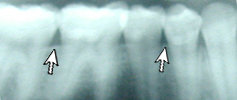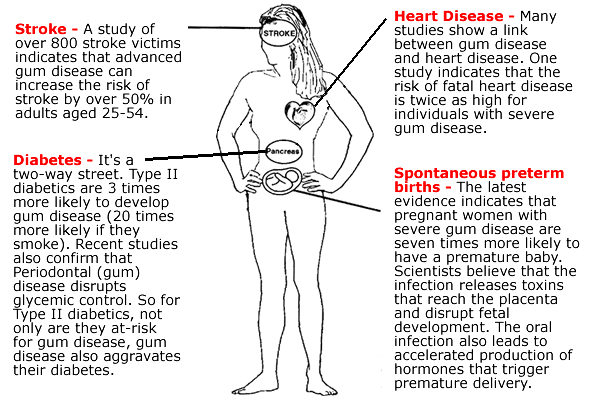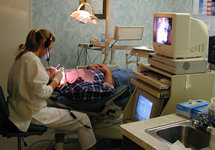What Is Gum Disease?
According to the American Dental Association, at least 60% of adults in the United States have moderate-to-severe gum disease! No doubt, you’ve heard some of the terms: Plaque, Tartar, Calculus, Gingivitis, Periodontitis, Pyorrhea, Periodontal Disease, and Gum Disease. But what does it all mean? Quite simply, Gum Disease (Periodontal Disease) starts when plaque and tartar (calculus) are allowed to accumulate at the base of your teeth. The bacteria in the plaque leads to an infection in the gums (gingiva) called Gingivitis. Left untreated, the infection spreads to the tissue and bone that holds your teeth in place, a condition called Periodontitis (Pyorrhea). Because of the bacterial infection associated with Periodontitis, tooth abscesses are also common.

This patient has Periodontitis. Notice the bone deterioration and uneven level of bone.

Healthy gums and bone.
What Are the Signs of Gum Disease?
Gum Disease is rarely painful, especially in the early stages. Although there may be no visible signs, some of the common indications of Gum Disease are:
- Gums that bleed when you brush or floss (healthy gums will not bleed)
- Gums that are red, swollen, or tender
- Gums that have pulled away from the teeth (receded)
- Pus (infection) between the teeth and gums
- Loose permanent teeth or separating (drifting) teeth
- Changes in the way your teeth fit together when chewing
- Persistent bad breath
What Are the Dangers of Gum Disease?
Gum Disease is the leading cause of tooth loss among adults. More importantly, the infection releases toxins into the bloodstream leading to serious health risks:

Is There a Cure?
Gum Treatment can effectively be used to treat and control even advanced cases of Periodontitis (Pyorrhea), but the more advanced the disease, the more likely it will lead to tooth loss. Prevention and Early Detection are your best defenses against Gum Disease. It is critical to catch and treat Gum Disease early before the destruction of bone and tissue has compromised your oral health.
How Can I Prevent Gum Disease?
The best “brushers” in the world will naturally build up tartar on their teeth. Even patients with “healthy” gums and teeth should see their dentist regularly to remove the build-up of tartar and check for the formation of new cavities. Patients with Gum Disease, or patients that build up large amounts of tartar, may need to have their teeth cleaned frequently to help control the number of bacteria in the mouth. At your regular recall appointments (Cleanings), we always evaluate the condition of your gums.

If you have any specific questions about Gum Disease that weren’t answered here, or if you would like an appointment for a Gum Disease screening, please Contact Us.